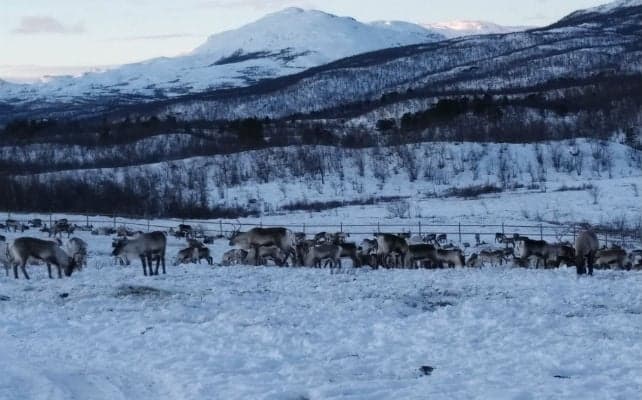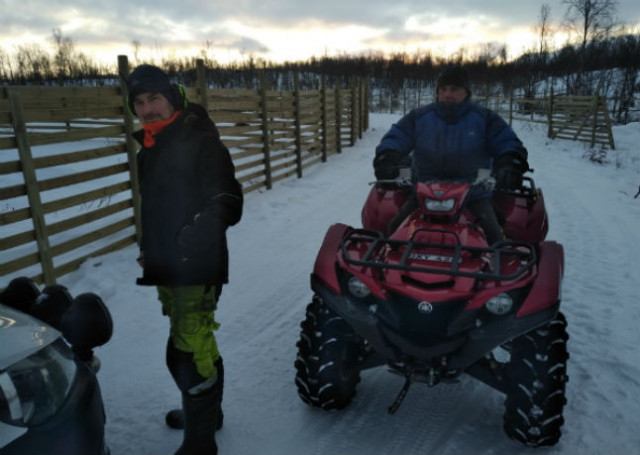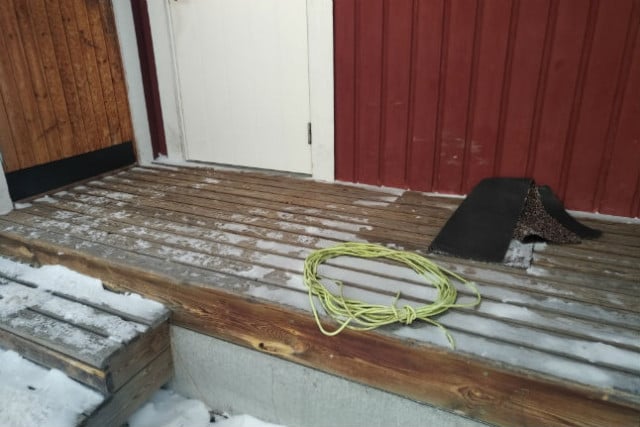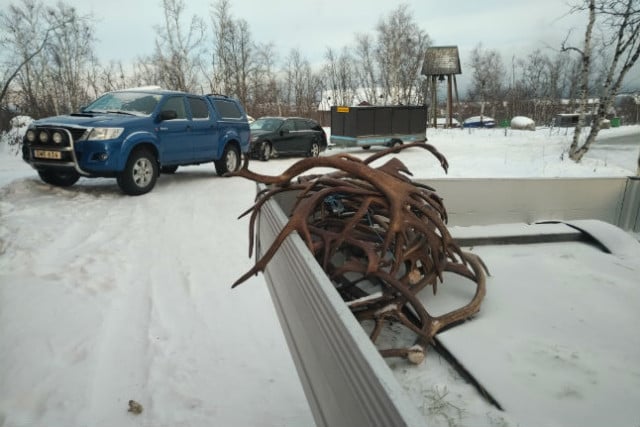Reindeer herders battle with a changing climate

Indigenous Sami reindeer herders are being severely affected by climate change. After last year's drought left reindeer short of food, this year there's been an excess of early snow.
In a small cabin on the outskirts of Abisko, a village in the far north of Swedish Lapland, three young men sit exhausted, bruised and battered, after two days trying to round up the reindeer scattered over the mountain behind them.
"It's like a bomb has hit: they're everywhere," Mattias Keinin, one reindeer owner says as he inspects the corral where he will later collect his animals.
For the past three days, young Sami men from Abisko and the neighbouring districts have been ranging far and wide over the national park in front of Lapporten, a dramatic u-shaped valley between two peaks, battling to gather the deer into an enormous pen.
Once collected, the several thousand animals will be sorted and moved down long corridors into the circular corral used to separate them according to which of a hundred or so families they belong to.
They will then be driven to the grazing areas where they will spend the winter.
 Christer Johansson (left) putting the final touches to the huge circular corral he has built in Abisko over the past two months. Photo: Richard Orange
This corral is happening at least a month early. The separation of the herd normally happens here in mid-December, says Christer Johansson, a Sami from a Övre Soppero, a village more than 100km away. He is here to finish off building the complex network of fences.
"There's so much snow now in the mountains, so the reindeer are coming down faster than we expected, so now now there's a little bit of a panic to get them down," he says. "They can't find any food up on the mountain, so they have to come down to the forest."
Christer Johansson (left) putting the final touches to the huge circular corral he has built in Abisko over the past two months. Photo: Richard Orange
This corral is happening at least a month early. The separation of the herd normally happens here in mid-December, says Christer Johansson, a Sami from a Övre Soppero, a village more than 100km away. He is here to finish off building the complex network of fences.
"There's so much snow now in the mountains, so the reindeer are coming down faster than we expected, so now now there's a little bit of a panic to get them down," he says. "They can't find any food up on the mountain, so they have to come down to the forest."
 A reindeer lasso left coiled up outside the cabin where the herders are resting. Photo: Richard Orange
Outside the cabin, there are snow scooters parked, their seats each covered in a warm reindeer skin. Bright yellow lassoes lie neatly looped on the doorstep. Animal trailers are parked ready to take reindeer away once they've been separated.
A reindeer lasso left coiled up outside the cabin where the herders are resting. Photo: Richard Orange
Outside the cabin, there are snow scooters parked, their seats each covered in a warm reindeer skin. Bright yellow lassoes lie neatly looped on the doorstep. Animal trailers are parked ready to take reindeer away once they've been separated.
Last year, the area faced the opposite problem, Johansson points out: the summer was unusually dry, leading to a shortage of food for the reindeer, and then in December, there was not enough snow.
According to Tim Horstkotte, a post doctoral researcher at the Swedish Agricultural University (SLU), greater weather variation is one of the challenges of global warming.
"One of the things with climate change is that it gets so unpredictable," he says. "If you compare it to last year's effect, it's completely the opposite. So this is one of the other things that reindeer herders are quick to point out: that it becomes unstable and unreliable. It's impossible almost to plan ahead, because things can change so dramatically in a short space of time."
READ ALSO:
-
Swedish reindeer herders call for rescue package after drought
-
IN PICTURES: Amazing images of reindeer herding in northern Sweden
-
Sami villages ask for emergency support as ice blocks reindeer from food
 Outside the cabin, cars, trucks and transporters are waiting to take the animals away. Photo: Richard Orange
Horstkotte says that the herders are quick to adapt, for instance using lorries to transport deer long distances to good grazing grounds, or laying down supplementary feeding on the ground.
On Wednesday, the herders used a helicopter to sweep over the forests of dwarf pines and birch, radioing in information on the location of different groups to the snowmobiles on the ground. But Horstkotte says the financial cost of such measures eats into the herders' profits.
Outside the cabin, cars, trucks and transporters are waiting to take the animals away. Photo: Richard Orange
Horstkotte says that the herders are quick to adapt, for instance using lorries to transport deer long distances to good grazing grounds, or laying down supplementary feeding on the ground.
On Wednesday, the herders used a helicopter to sweep over the forests of dwarf pines and birch, radioing in information on the location of different groups to the snowmobiles on the ground. But Horstkotte says the financial cost of such measures eats into the herders' profits.
"They often point out that they are experts in survival and have been living in this landscape for centuries, so they are quite successful in adapting," he says. "That their ability to do so comes at a certain financial cost."
Add climate change to the risk of reindeer being killed by wolves, bears or eagles, or run over by a train, and the low prices the herders receive for meat and skins is hardly sufficient.
"Hardly anyone lives off this," says Johansson. "It's expensive. You need a snowmobile, a quad bike, that's 150,000 SEK easy. You need at least 2,000 or 3,000 reindeer to live off it."
He says that almost every Sami reindeer owner he knows does it as a side job.
"If you see someone with an old snowmobile, and an old quad bike, then they might live from it. Everyone else has another job. It's more like a hobby."
Comments
See Also
In a small cabin on the outskirts of Abisko, a village in the far north of Swedish Lapland, three young men sit exhausted, bruised and battered, after two days trying to round up the reindeer scattered over the mountain behind them.
"It's like a bomb has hit: they're everywhere," Mattias Keinin, one reindeer owner says as he inspects the corral where he will later collect his animals.
For the past three days, young Sami men from Abisko and the neighbouring districts have been ranging far and wide over the national park in front of Lapporten, a dramatic u-shaped valley between two peaks, battling to gather the deer into an enormous pen.
Once collected, the several thousand animals will be sorted and moved down long corridors into the circular corral used to separate them according to which of a hundred or so families they belong to.
They will then be driven to the grazing areas where they will spend the winter.

Christer Johansson (left) putting the final touches to the huge circular corral he has built in Abisko over the past two months. Photo: Richard Orange
This corral is happening at least a month early. The separation of the herd normally happens here in mid-December, says Christer Johansson, a Sami from a Övre Soppero, a village more than 100km away. He is here to finish off building the complex network of fences.
"There's so much snow now in the mountains, so the reindeer are coming down faster than we expected, so now now there's a little bit of a panic to get them down," he says. "They can't find any food up on the mountain, so they have to come down to the forest."

A reindeer lasso left coiled up outside the cabin where the herders are resting. Photo: Richard Orange
Outside the cabin, there are snow scooters parked, their seats each covered in a warm reindeer skin. Bright yellow lassoes lie neatly looped on the doorstep. Animal trailers are parked ready to take reindeer away once they've been separated.
Last year, the area faced the opposite problem, Johansson points out: the summer was unusually dry, leading to a shortage of food for the reindeer, and then in December, there was not enough snow.
According to Tim Horstkotte, a post doctoral researcher at the Swedish Agricultural University (SLU), greater weather variation is one of the challenges of global warming.
"One of the things with climate change is that it gets so unpredictable," he says. "If you compare it to last year's effect, it's completely the opposite. So this is one of the other things that reindeer herders are quick to point out: that it becomes unstable and unreliable. It's impossible almost to plan ahead, because things can change so dramatically in a short space of time."
READ ALSO:
- Swedish reindeer herders call for rescue package after drought
- IN PICTURES: Amazing images of reindeer herding in northern Sweden
- Sami villages ask for emergency support as ice blocks reindeer from food

Outside the cabin, cars, trucks and transporters are waiting to take the animals away. Photo: Richard Orange
Horstkotte says that the herders are quick to adapt, for instance using lorries to transport deer long distances to good grazing grounds, or laying down supplementary feeding on the ground.
On Wednesday, the herders used a helicopter to sweep over the forests of dwarf pines and birch, radioing in information on the location of different groups to the snowmobiles on the ground. But Horstkotte says the financial cost of such measures eats into the herders' profits.
"They often point out that they are experts in survival and have been living in this landscape for centuries, so they are quite successful in adapting," he says. "That their ability to do so comes at a certain financial cost."
Add climate change to the risk of reindeer being killed by wolves, bears or eagles, or run over by a train, and the low prices the herders receive for meat and skins is hardly sufficient.
"Hardly anyone lives off this," says Johansson. "It's expensive. You need a snowmobile, a quad bike, that's 150,000 SEK easy. You need at least 2,000 or 3,000 reindeer to live off it."
He says that almost every Sami reindeer owner he knows does it as a side job.
"If you see someone with an old snowmobile, and an old quad bike, then they might live from it. Everyone else has another job. It's more like a hobby."
Join the conversation in our comments section below. Share your own views and experience and if you have a question or suggestion for our journalists then email us at [email protected].
Please keep comments civil, constructive and on topic – and make sure to read our terms of use before getting involved.
Please log in here to leave a comment.